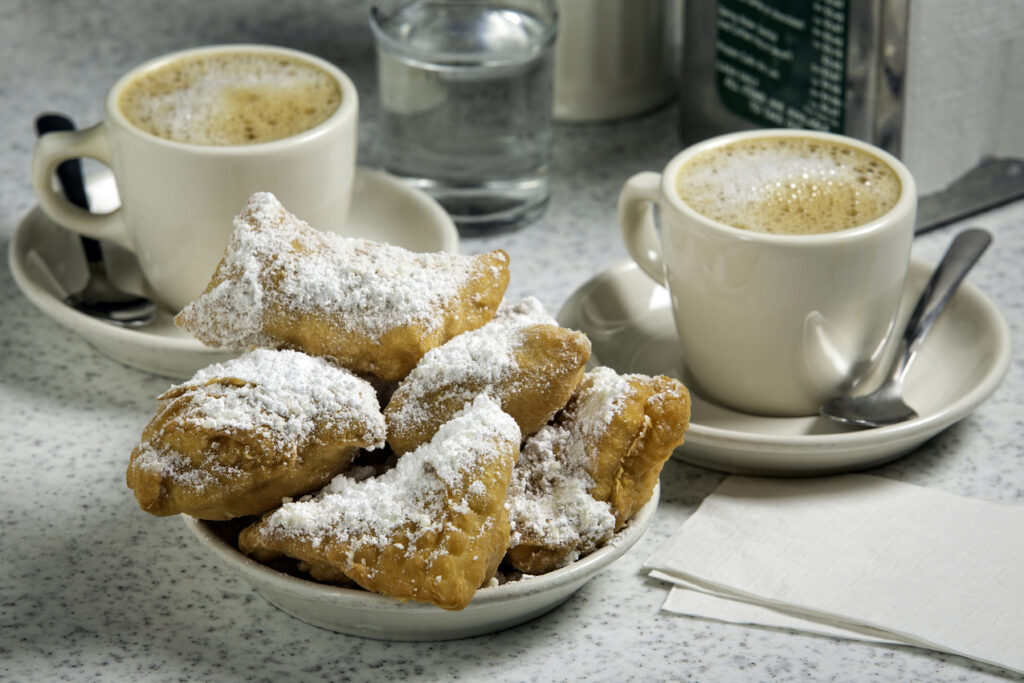
PHOTO CREDIT: Louisiana Office of Tourism
Beignet: What is it? Pillowy fried dough, doused with powdered sugar. Where to find it: Café Du Monde in New Orleans’ French Quarter is the unofficial world capital of beignets. New Orleans even has an annual Beignet Festival featuring beignets with both savory and sweet ingredients.
Po’boy: What is it? A submarine-type sandwich made most popularly with fresh fried seafood or roast beef on French bread. Where to find it: New Orleans’ Oak Street Po’Boy Festival! Or, Darrell’s in Lake Charles is famous for serving up both the classics and new innovations like the Darrell’s Special.
Étouffée: What is it? A Creole dish of rice smothered in a stew of roux, crawfish or shrimp, herbs and vegetables. Where to find it: You’ll find mouthwatering étouffée at The Chimes in Baton Rouge, along the Bayou Country Crawfish Trail in the Houma Area, and at the Étouffée Festival in Arnaudville.
Gumbo: What is it? An irresistible amalgamation of dark roux, rice, seafood or chicken & sausage, “trinity” (onions, bell peppers and celery), and often okra. Where to find it: Rocky and Carlo’s in Chalmette has one of the best bowls in south Louisiana. In northeast Louisiana, Warehouse No. 1 in Monroe is the spot. Or, sample them all at the Bridge City Gumbo Festival.
Boudin: What is it? Rice, pork and spices in a sausage casing. Boudin is often served in links or as fried boudin balls. Where to find it: Head to Scott, the Boudin Capital of the World, to grab some at Don’s Specialty Meats or the Scott Boudin Festival. Or, eat your way across the SWLA Boudin Trail in the Lake Charles area.
Andouille: What is it? Pork butt, shank and fat, seasoned with salt, garlic and cracked black pepper and smoked over pecan wood and sugar cane for a sweet, rich flavor. Where to find it: On the Andouille Trail in Louisiana’s River Parishes, of course! Don’t miss the Andouille Festival in the area, as well.
Jambalaya: What is it? A Creole rice dish containing chicken, sausage, and the trinity. Served traditionally out of a cast iron pot. Where to find it: Start in Gonzales, known as the world capital of jambalaya — the Jambalaya Festival is held there every May. Trapp’s in West Monroe also serves a popular bowl.
Praline: What is it? A sugary, buttery candy made from butter, brown sugar and pecans, cooked in a kettle and dried on wax paper. French nuns brought these Creole treats to New Orleans in the 1700s. Where to find it: Aunt Sally’s Pralines in New Orleans’ French Market is among the most famous.
Shreveport-Style Stuffed Shrimp: What is it? Large fried shrimp, stuffed with a Creole dressing and served with spicy tartar sauce. This local delicacy was cooked up in the 1950s by Freeman & Harris Café, a historic black-owned restaurant that fed legends like Rev. Martin Luther King Jr. and B.B. King. Where to find it: Orlandeaux’s continues the legacy today!
Meat Pie: What is it? A fried pie, similar to an empanada, filled with beef and pork and seasonings. A perfect side for a handheld on-the-go treat. Where to find it: Meat Pies are the signature dish of Natchitoches. Find them at Lasyone’s Meat Pie Restaurant and the Natchitoches Meat Pie Festival.
Cracklins: What is it? Think pork rinds, but meatier and fattier. Crunchy fried skin, soft and juicy rendered fat, and a bit of meat provide the perfect one-bite snack. Where to find it: These are a Cajun specialty found at Billy’s Boudin & Cracklins in Krotz Spings and Hebert’s Boudin & Cracklins in Opelousas. And of course, there’s the Port Barre Cracklin Festival.
 Escape To The Southeast Escape To The Southeast
Escape To The Southeast Escape To The Southeast

